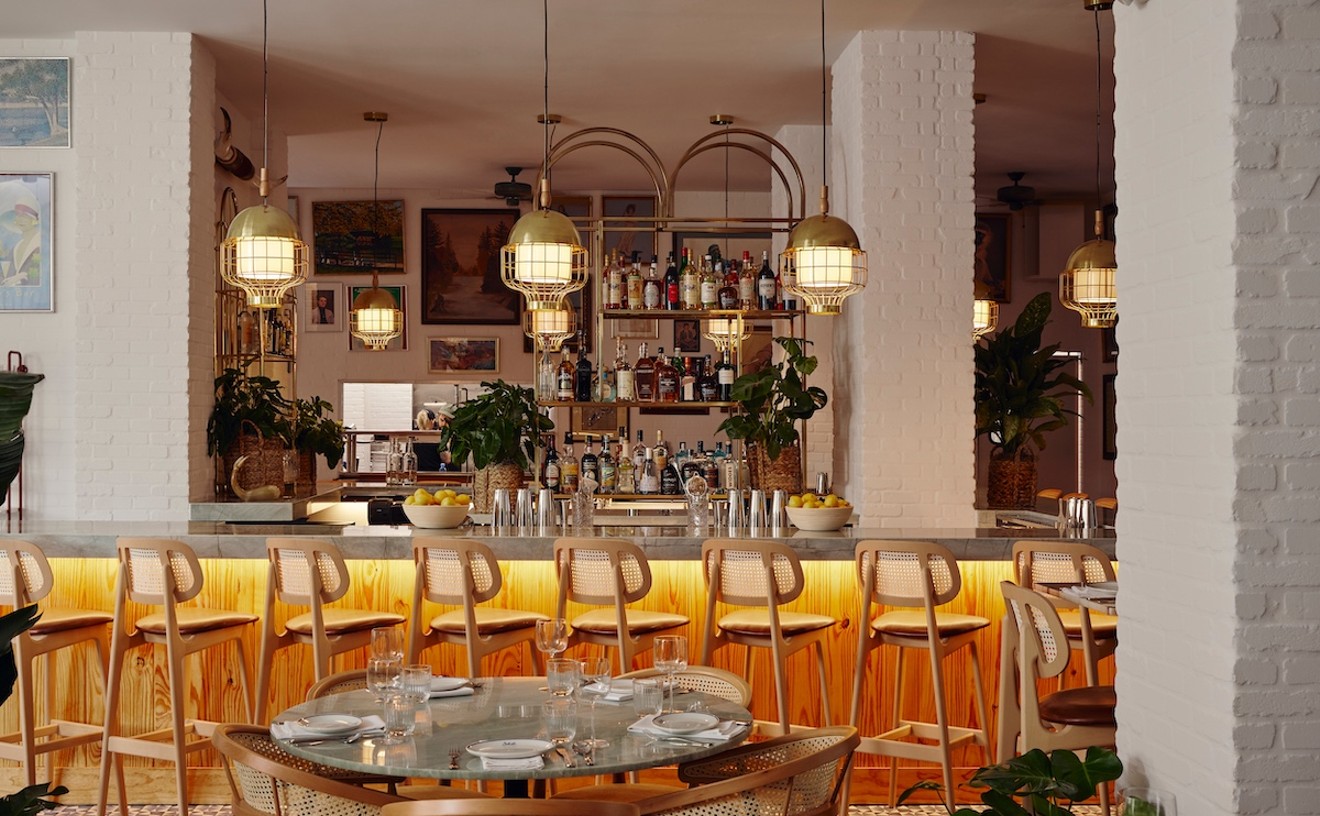The local crowd doesn't seem to mind the antiquated appointments; most appear to be no youngsters themselves. Owner/manager Perfecte Olivira greets them warmly, many by name, the friendly welcome supported by a talented and tuxedoed staff; no one waits long for menus, water, or warm bread served with a complimentary tapas plate of thinly sliced chorizo and Serrano ham. The former tasted more like cappicola, but that's okay too.
Solmar bills its food as "cocina continental," which translates to Continental cuisine with an inkling of ingredients and regional specialties from Spain. Soups exemplify this Spanish/Continental divide, options traveling from French onion to fabada Asturiana, the latter a full-flavored, tomato-based broth boosted by white beans and meaty with thick hunks of ham, chorizo, and blood sausage.
A mixed hors d'oeuvres starter brings the same two cold cuts served as tapas, with the addition of only a wedge of Manchego cheese -- Spanish, yes, but also redundant and resoundingly unimpressive. Other appetizers on the compact menu include routine versions of shrimp cocktail and escargot, and a quartet of plump shrimp sizzled with clarified butter and a smattering of garlic.
Corvina is the lone fish offered, two fresh, thick, lean white fillets available grilled, broiled, egg-battered and pan-fried, or baked in salsa verde, a mildly acidic white wine sauce streaked with garlic and greened with parsley. Either shrimp or lobster can be ordered in piquant, tomato-based fra diavolo sauce, shrimp likewise available scampi-style, presumably similar to the shrimp in garlic-butter appetizer. Choice of two sides accompanies each main course -- white rice, French fries (greasy), mashed potatoes (soft and rich), or assorted vegetables (frozen, which is not really acceptable in this day and age).
Filet mignon and sirloin steaks are broiled and brandished with garnishes -- Cabrales cheese, shrimp, bordelaise sauce, and so on. Prices are more than fair: Most entrées, including steaks, are less than $25, and many under $20. A wondrously tender pair of meaty veal cutlets, studded with mushrooms and ham in a smooth Madeira sauce, is a steal at $15.95. Even the specialty of the house, paella, is less than $20 per person, although the "55 minute" preparation time can be a problem. It's no big deal if you're sharing a bottle of wine or pitcher of apple-flecked sangria with friends, but there are hardly enough appetizers on the menu to fill such a gap, especially if you're dining with only one other person. In any case, the wait is well rewarded with a sturdy rendition replete with requisite chicken, chorizo, and shellfish. We wanted to try bacalao Vizcaina, the other house specialty, but the kitchen was all out.
Solmar succeeds as a solid Spanish/Continental restaurant, though like so many ethnic eateries in Miami, it does so while thoroughly ignoring culinary evolution over the past 40 years. It is particularly painful to see a Spanish establishment so impervious to the 21st Century, which has opened with Spain surfing on foams and gels to the top of the gastronomic world. That's not to say Solmar needs to Bulli-up its menu, but there are ways to be creative, or at least a bit more ambitious, even within the constraints of traditional, moderately priced dining.
Owner Larry Harris (founder of Pollo Tropical) and executive chef Jordi Valls do just that at Salero tapas bar/café in the Brickell Village neighborhood. The restaurant is housed on the main floor of the Firehouse Four building, a two-story Mediterranean Revival structure built as Miami's fourth firehouse in 1923; upstairs is its sister Spanish restaurant Mosaico. A patio out front provides perfectly pleasant alfresco dining, while indoors is a handsome 50-seat room with mosaic-tiled floors and multiple seating options -- upon a couch, on a stool at a tall cocktail circular table, in a regular chair at a regular table, or at one of a dozen cushy and colorful seats that line a luminous bar. Salero resembles many a tapas joint in Spain, but you could just as easily mistake it for a Parisian side-street bistro.
Although an alumnus of El Bulli, where he trained under deconstructionist master Ferren Adrià, Valls tenders a tempered version of that brash cuisine at Mosaico, while on the ground level he abandons the avant-garde altogether and dishes up traditional tapas -- or more accurately, raciones, which are larger, more sharable portions. Cold plates include the obligatory servings of Serrano ham and Manchego cheese, as well as other common tapas prepared in uncommonly deft fashion: white anchovy fillets delicately marinated in vinegar; ever-so-lightly fried chunks of potato dressed in smoky, piquant paprika dressing striped with white garlic sauce; a trio of fresh tuna squares, seared rare, skewered with olives and jazzed with gazpacho pepper sauce (a prime example, incidentally, of being inventive within a conventional context). Hot tapas were handled with equal aplomb, one cazuela brimming with crisply fried calamari, another with assertively charred chorizo -- although there was no sign of the spicy sausage having been prepared "a la sidra" as advertised, which implies flaming with apple cider. Of course an extensive selection of Spanish wines and sherries is available by bottle, glass, or flight, for tapas without wine are like French fries without ketchup.
Cazuelas likewise come stocked with entrée-style foods, such as a juicy, flame-broiled churrasco smothered in sherried mushrooms, and a half-chicken baked with numerous shrimp in a splendid, spicy mélange of minced onions, red peppers, and Serrano ham. A miniparillada features churrasco, chorizo, and grilled lamb chops -- great deal for $15, as is the parillada de mariscos, a daily selection of grilled fish and shellfish for $19. For an uncomplicated dinner without tapas, try the churrasco or chicken with a make-your-own salad -- a generous mound of romaine or spring mix decorated with choice of five toppings (this would come to $21 or $22, which is not bad at all). Salero successfully stakes the middle ground between bulls' heads and Bulli.











